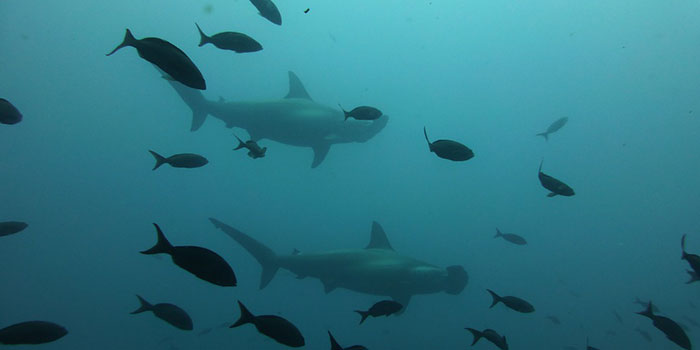
Check this Top 5 about Sharks seen in Galapagos!
More than 400 fish species have been documented inside the deep ocean that surrounds each one of the Galapagos Islands. Among these species, sharks are very common, and some of them are even endangered or endemic.
Apart from these facts, Galapagos sharks portray special characteristics that make them unique in the world, just as every single species in the Archipelago. Read here about the most famous sharks you can find on your trip to Galapagos:
1. Scalloped Hammerhead Shark (Sphyrna lewini)
- Spanish name: Tiburón martillo: Although they are currently endangered, these are the most common and iconic hammerhead sharks in Wolf and Darwin islands, along with the great hammerheads, which are mentioned in the next point, and the smooth hammerheads.
- They can reach from 2.5 to 4.2 meters, their average lifespan is 20 to 30 years, their weight can vary between 80 and 150 kilograms, and their most peculiar feature is having their eyes really close to their nostril. They also have a three-lobed head which makes them become such a particular species.
- They can be found in tropical/warm temperate waters from the Atlantic, Pacific and Indian Oceans. They form large schools.
- They usually feed on fish (sardines, mackerels and herrings), and sometimes on some crustaceans, squids, stingrays and cephalopods. Their pups are highly endangered due to other sharks that eat them.
2. Great Hammerhead Shark (Sphyrna mokarran)
- Spanish name: Tiburón martillo gigante. These sharks are the largest hammerheads. They are also very rare on coral reefs and can be found in tropical and temperate waters from all around the world.
- Their highest length is 6.1 meters, and their most interesting feature is their cephalofoil (better known as their hammer-shaped head), which helps them to immobilize stingrays. Their dorsal fin is pointed and high.
- They are solitary predators and eat mostly bony fish, cephalopods, rays or smaller sharks, but also crustaceans and cephalopods.
- They have been hunted due to their large fins which are used for the popular shark fin soup, so nowadays they are endangered.
3. Galapagos Bullhead Shark (Heterodontus quoyi)
- Spanish name: Suño de Galápagos
- This species is endemic and rare. It is found in the tropical eastern Pacific Ocean.
- Its second most common name is Port Jackson horned shark, but the real shark that holds this name (Heterodontus portusjacksoni) lives only in Australia.
- They have a box-shaped head, a sharp spine or horn on both dorsal fins, and a big ridge over their eyes.
- They feed on most crustaceans such as crabs, and also shellfish.
4. Whale Shark (Rhincodon typus)
- Spanish name: Tiburón ballena: This is the largest species shark and the largest fish alive in the world, and that’s the reason of its name. They are also endangered, even if they can be found in many warm and temperate seas.
- It can reach a length of 10 to 12 or even 18 to 20 meters, and a weight of 15 to 30 tons. Its main colors are gray to blue and it has an irregular pattern made from white stripes and spots. Compared to their bodies, their eyes are small.
- It is a planktivore shark: it mostly feeds on zooplankton, but also on pelagic crustaceans, tiny fish and squids.
- Human beings, specifically in China, are their worst threat: illegal Chinese fishers have been reported to kill more than 600 whale sharks per year.
5. Galapagos Shark (Carcharhinus galapagensis)
- Spanish name: Tiburón de Galápagos
- These are very similar to the grey reef sharks, though Galapagos sharks have rounder heads and thicker bodies, mostly in their tails. If you like snorkeling, you could spot one of them during your stay in Galapagos. They are Near Threatened in the Conservation Status scale.
- They can reach from 2.5 to 3.7 meters and can weigh up to 150 kilograms. They have the most beautiful colors: their upper body is gray and brown, and their lower body is yellow and white. They also have long pectoral fins.
- Their main food is marine iguanas, fish such as triggerfish or flatfish, squids, octopuses and sea lions.
Galapagos Islands are still the best place to see all of these species much closer than on TV documentaries. Galapagos Center Expeditions takes you to this paradise where sharks are one of the greatest attractions for snorkelers and divers in general. Wolf and Darwin Islands are our recommended top spots to begin the journey in search of sharks!




